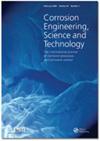Corrosion behaviours of Ni-Mo-Cr alloy and 316 stainless steel in molten NaCl-KCl-AlCl3 salts at high temperature
IF 1.5
4区 材料科学
Q4 MATERIALS SCIENCE, MULTIDISCIPLINARY
Corrosion Engineering, Science and Technology
Pub Date : 2022-11-23
DOI:10.1080/1478422X.2022.2148855
引用次数: 1
Abstract
ABSTRACT The corrosion behaviours of Ni-Mo-Cr alloy and 316 stainless steel samples after immersing in NaCl-KCl-AlCl3 salt at 400.0°C for 168 h were investigated. The surface of Ni-Mo-Cr alloy basically kept its pre-corrosion morphology, with only a few corrosion pits. While NaCl-KCl-AlCl3 salt had stronger corrosivity to 316SS. After corrosion, the grain boundary of the surface of 316SS alloy was clearly visible, and the Fe and Cr atoms on the surface of 316SS were selectively corroded, leaving a Ni- rich layer of about 6.5 µm on the outmost surface of 316SS. At the temperature of 400.0°C, the corrosion resistance of Ni-Mo-Cr alloy to molten NaCl-KCl-AlCl3 salt was better than that of 316SS.Ni-Mo-Cr合金和316不锈钢在NaCl-KCl-AlCl3熔盐中的高温腐蚀行为
摘要Ni-Mo-Cr合金和316不锈钢样品在400.0°C NaCl-KCl-AlCl3盐中浸泡168天后的腐蚀行为 h。Ni-Mo-Cr合金表面基本保持了腐蚀前的形态,只有少量的腐蚀坑。NaCl-KCl-AlCl3盐对316SS具有较强的腐蚀性。腐蚀后,316SS合金表面的晶界清晰可见,316SS表面的Fe和Cr原子被选择性腐蚀,留下约6.5的富Ni层 在316SS的最外表面上为µm。在400.0°C的温度下,Ni-Mo-Cr合金对熔融NaCl-KCl-AlCl3盐的耐蚀性优于316SS。
本文章由计算机程序翻译,如有差异,请以英文原文为准。
求助全文
约1分钟内获得全文
求助全文
来源期刊

Corrosion Engineering, Science and Technology
工程技术-材料科学:综合
CiteScore
3.20
自引率
5.60%
发文量
58
审稿时长
3.4 months
期刊介绍:
Corrosion Engineering, Science and Technology provides broad international coverage of research and practice in corrosion processes and corrosion control. Peer-reviewed contributions address all aspects of corrosion engineering and corrosion science; there is strong emphasis on effective design and materials selection to combat corrosion and the journal carries failure case studies to further knowledge in these areas.
 求助内容:
求助内容: 应助结果提醒方式:
应助结果提醒方式:


